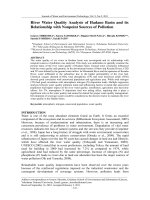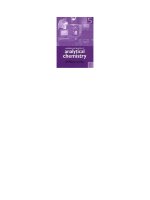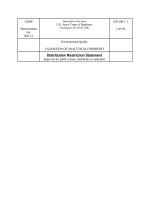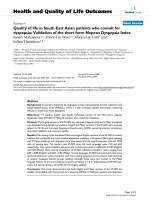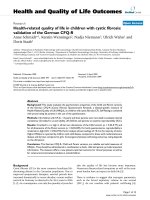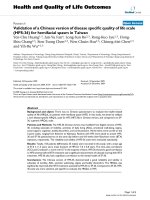Environmental quality validation of analytical chemistry laboratories
Bạn đang xem bản rút gọn của tài liệu. Xem và tải ngay bản đầy đủ của tài liệu tại đây (2.14 MB, 499 trang )
CEMP
Memorandum
No.
200-1-1
Department of the Army
U.S. Army Corps of Engineers
Washington, DC 20314-1000
EM 200-1-1
1 Jul 94
Environmental Quality
VALIDATION OF ANALYTICAL CHEMISTRY
Distribution Restriction Statement
Approved for public release; distribution is unlimited.
CEMP-RT
CECW-E
DEPARTMENT OF THE ARMY
U.S. Army Corps of Engineers
Washington, DC 20314-1000
EM 200-1-1
Manual
No. 200-1-1
1 July 1994
Environmental Quality
VALIDATION OF ANALYTICAL CHEMISTRY LABORATORIES
Table of Contents
Subject
Paragraph Page
CHAPTER 1.
1-1 1-1
1-2 1-1
1-3 1-1
1-4 1-1
1-5 1-2
1-6 1-8
1-7 1-8
CHAPTER 2.
2-1 2-1
2-1 2-1
2-3 2-5
2-4 2-15
2-5 2-23
Section II.
2-6 2-26
2-7 2-27
2-8 2-28
Section III.
INTRODUCTION
Purpose
Applicability
References
Overview
Responsibilities
Expenses and, Funding
Effective Date and Amendments
PROCEDURES FOR COMMERCIAL LABORATORIES
Validation Procedures
Initiation Procedures
Implementation Procedures
Implementation Procedure Steps
Approval Procedures
Inspection/Evaluation Report
Revalidation, Termination, and Appeal
Revalidation
Termination
Appeal
Information Management
Record Files
Database
2-9 2-31
2-10 2-31
CHAPTER 3.
PROCEDURES FOR USACE DIVISION LABORATORIES
USACE Division Laboratories
Contract QA Laboratories
3-1 3-1
3-2 3-2
i
EM 200-1-1
1 Jul 94
Page
APPENDIX A
APPENDIX B
Appendices
REFERENCE
A-1
INTRODUCTION TO THE U.S. ARMY CORPS
OF ENGINEERS VALIDATION PROGRAM FOR
COMMERCIAL ANALYTICAL CHEMISTRY
LABORATORIES
B-1
APPENDIX C
C-1
APPENDIX D
D-1
APPENDIX E
E-1
APPENDIX F
F-1
APPENDIX G
G-1
APPENDIX H
H-1
APPENDIX I
APPENDIX J
APPENDIX K
APPENDIX L
INFORMATION FOR COMMERCIAL ANALYTICAL
CHEMISTRY LABORATORIES UNDERGOING
VALIDATION BY THE U.S. ARMY CORPS OF
ENGINEERS
GUIDELINES FOR ANALYZING AND REPORTING
PERFORMANCE EVALUATION SAMPLES FROM
THE U.S. ARMY CORPS OF ENGINEERS
PRELIMINARY QUESTIONNAIRE FOR THE U.S.
ARMY CORPS OF ENGINEERS VALIDATION
PROGRAM FOR ANALYTICAL CHEMISTRY
LABORATORIES
ANALYTICAL PARAMETERS, METHODS, AND FEE
SCHEDULE FOR PERFORMANCE EVALUATION
SAMPLES FROM THE U.S. ARMY CORPS
OF ENGINEERS
GUIDANCE FOR PREPARATION, HANDLING, AND
VALIDATION OF PERFORMANCE EVALUATION
SAMPLES
GUIDELINES AND CRITERIA FOR ON-SITE
INSPECTION OF COMMERCIAL ANALYTICAL
CHEMISTRY LABORATORIES
CHECKLISTS FOR ON-SITE LABORATORY
INSPECTIONS
I-1
SHORT CHECKLISTS FOR ON-SITE LABORATORY
INSPECTIONS
J-1
SAMPLE RECORD OF THE LABORATORY
VALIDATION DATABASE
K-1
SUPPLEMENTAL QUESTIONNAIRE FOR VALIDATION
OF USACE DIVISION LABORATORIES
L-1
ii
EM 200-1-1
1 Jul 94
Appendices
Page
APPENDIX M LIST OF ABBREVIATIONS, ACRONYMS, FORMULAS
M-1
SYMBOLS, NUMBERS, AND TERMS
iii
EM 200-1-1
1 Jul 94
Figures
FIGURE 1-1
Page
1-3/
1-4
FIGURE 2-1
FIGURE 2-2
FIGURE 2-3
FIGURE 2-4
FIGURE C-1
FIGURE C-2
FIGURE H-1
FIGURE H-2
FIGURE H-3
FIGURE H-4
FIGURE K-1
FLOW DIAGRAM OF COMMERCIAL LABORATORY
VALIDATION PROCEDURES
LABORATORY EVALUATION REQUEST FORMAT
ON-SITE LABORATORY INSPECTION SUMMARY
VALIDATION REVIEW MEETING SUMMARY
LABORATORY PERFORMANCE PROBLEM REPORT
SAMPLE LABORATORY EVALUATION REQUEST
FLOW DIAGRAM OF COMMERCIAL LABORATORY
VALIDATION PROCEDURES
PRE-INSPECTION CHECKLIST
ENTRANCE INTERVIEW CHECKLIST
EXIT INTERVIEW CHECKLIST
COOLER RECEIPT CHECKLIST
SAMPLE RECORD OF THE LABORATORY
VALIDATION DATABASE
2-2
2-16/
2-18
2-20/
2-21
2-29/
2-30
C-3
C-9/
C-10
H-3/
H-4
H-5/
H-6
H-9
H-12
K-2/
K-6
iv
EM 200-1-1
1 Jul 94
Tables
Page
TABLE 2-1
SAMPLE FORMAT FOR INSPECTION REPORT
2-24/
2-25
v
CEMP-RT
CECW-E
Manual
No. 200-1-1
DEPARTMENT OF THE ARMY
U.S. Army Corps of Engineers
Washington, DC 20314-1000
EM 200-1-1
1 July 1994
Environmental Quality
VALIDATION OF ANALYTICAL CHEMISTRY LABORATORIES
1. Purpose. This manual implements the USACE policy and
requirements on validation of analytical chemistry laboratories
as prescribed in the USACE Engineer Regulation 1110-1-263. This
manual provides detailed procedures, guidance, and criteria for
validation of commercial and USACE Division analytical chemistry
laboratories. Laboratory validation is required to ensure that
analytical chemistry laboratories meet the minimum requirements
of the USACE quality assurance/quality control program that
facilitates the generation of chemical data of known and
acceptable quality.
2. Applicability.
This manual applies to HQUSACE/OCE elements,
major subordinate commands, districts, laboratories, and separate
field operating activities having responsibility for in-house or
contracted projects involving chemical measurements of waste
and/or environmental samples. This includes, but is not limited
to, execution of the following programs: Defense Environmental
Restoration Program; Base Realignment and Closure; Installation
Environmental Compliance; Military Construction; Superfund; Civil
Works; and Department of Energy.
FOR THE COMMANDER:
WILLIAM D. BROWN
Colonel, Corps of Engineers
Chief of Staff
EM 200-1-1
1 Jul 94
CHAPTER 1
INTRODUCTION
1-1. Purpose. This manual implements policy and provides
guidance, procedures, and criteria for the validation of
commercial and U.S. Army Corps of Engineers (USACE) division
analytical chemistry laboratories. Laboratory validation is
required to ensure that analytical chemistry laboratories meet
the USACE Chemical Data Quality Management (CDQM) requirements as
prescribed in the USACE Engineer Regulation (ER) 1110-1-263 for
generation of chemical data of sufficient quality to meet
intended usages within the project.
1-2. Applicability.
a. This manual applies to HQUSACE/OCE elements, major
subordinate commands, districts, laboratories, and separate field
operating activities (FOA) having responsibility for in-house or
contracted projects involving chemical measurements of waste
and/or environmental samples. This includes, but is not limited
to, execution of the following programs: Defense Environmental
Restoration Program (DERP); Base Realignment and Closure (BRAC);
Installation Environmental Compliance; Military Construction;
Superfund; Civil Works; and Department of Energy (DOE).
b. This manual and its prescribed laboratory validation
process also apply to the validation of USACE division
laboratories with minor modifications. USACE division
laboratories and commercial laboratories, which perform the QA
function, shall be evaluated under more stringent criteria than
commercial primary project laboratories.
1.3 References.
a. ER 1110-1-263, Chemical Data Quality Management for
Hazardous Waste Remedial Activities.
b. “Hazardous, Toxic & Radioactive Waste (HTRW) - Policy
Guidance on Validation of Commercial Analytical Chemistry
Laboratories”, CEMP-RT memorandum, (See Appendix A.)
1-4. Overview.
a. The purpose of laboratory validation is to ensure that
analytical chemistry laboratories meet the minimum requirements
of the USACE quality assurance/quality control (QA/QC) program
that facilitates the generation of chemical data of known and
1-1
EM 200-1-1
1 Jul 94
acceptable quality. Objectives of commercial laboratory
validation are: to communicate USACE QA/QC requirements; to
verify that commercial laboratories are performing specified
analytical methods with no unacceptable deviations; and to verify
these laboratories meet USACE QA/QC requirements prior to sample
analysis. In general, all commercial laboratories that support
USACE HTRW response activities shall obtain a USACE laboratory
validation prior to field studies or sample analyses and shall
maintain the validated status throughout the response activities.
Appendix B is an introduction to laboratory validation procedures
for commercial laboratories that express interest in USACE
laboratory validation but have not been tasked to execute
chemical analysis in support of USACE HTRW response activities.
b. The USACE laboratory validation process consists of
three major sequential steps: (1) review of general
qualifications,
(2) analysis of performance evaluation (PE)
samples,
and (3) on-site laboratory inspection.
The validation
provides a parameter, method,
and matrix-specific approval.
The
period of validation is 18 months.
For each new contract/
project/task order (hereafter referred to as the contract or
project) awarded to a commercial laboratory after its initial
validation,
a project-specific evaluation of the laboratory’s
capability and past performance is still required.
A simplified
flow diagram is shown in Figure 1-1 to show the major events in a
laboratory validation process.
c. Abbreviations, acronyms, formulas, symbols, numbers,
and terms used in this manual are defined in Appendix M.
1-5. Responsibilities.
The USACE HTRW Mandatory Center of
Expertise (HTRW MCX) located at the Missouri River Division in
Omaha,
Nebraska is tasked by HQUSACE with the operation and
management responsibilities for this centralized laboratory
validation program. A Laboratory Validation Committee (hereafter
referred to as the Committee), composed of staff members from the
Chemistry Branch of the HTRW MCX, is generally responsible for
all aspects of the USACE HTRW laboratory validation program. One
of the Committee members is designated as the Laboratory
Validation Coordinator (hereafter referred to as the Coordinator)
who is the point-of-contact for the Committee and is responsible
for coordination and execution of the daily activities of the
laboratory validation process.
The Committee will meet as needed
and is primarily responsible for proposing policy and making
ultimate decisions with regard to laboratory-specific validation
status.
Besides the Committee, a number of other parties,
including government agencies and private contractors, are
involved in the USACE HTRW laboratory validation process.
1-2
EM 200-1-1
1 Jul 94
Figure 1-1. Flow Diagram of Commercial Laboratory Validation
Procedures
1-3
EM 200-1-1
1 Jul 94
Figure 1-1. Flow Diagram of Commercial Laboratory Validation
Procedures (continued)
1-4
EM 200-1-1
1 Jul 94
Details on the responsibilities of all involved parties are
addressed below.
a. HQUSACE:
(1) Actively performs oversight for the USACE HTRW
laboratory validation program.
(2) Administers approval authority for the policies and
procedures of the USACE HTRW laboratory validation program.
b. The Committee, HTRW MCX:
(1) Is responsible for all aspects of the USACE HTRW
laboratory validation program including planning, programming,
execution, budget, and management.
(2) Coordinates laboratory validation activities and
provides liaison with various government agencies and private
sector parties on laboratory validation issues. Ensures all
laboratory evaluations and/or validations are successfully
completed in a timely manner.
(3) Identifies the PE samples and analytical methods
required for each laboratory validation. Assures that PE sample
suppliers are provided with proper information to prepare and
ship PE samples.
(4) Monitors the performance of PE sample suppliers
through review of their most recent analytical results of any
proficiency testing programs and all QA/QC data associated with
the verification of PE samples on a quarterly basis. Also
conducts on-site audits of PE sample suppliers on a regular
basis.
(5) Reviews the qualification documents of commercial
laboratories, evaluates PE sample results, and conducts or
delegates on-site laboratory inspections.
(6) Trains USACE personnel to perform on-site laboratory
inspections. Monitors the inspector's performance to ensure that
consistent inspection approach and results of high quality are
carried out within the USACE HTRW laboratory validation program.
(7) Decides the pass/fail status for each step of the
laboratory validation process, additional work required for
completion of laboratory validation, or the appropriate time to
terminate a laboratory validation process or to revoke an active
validation status.
1-5
EM 200-1-1
1 Jul 94
(8) Prepares and distributes laboratory inspection and
evaluation reports.
(9) Establishes and maintains a performance database for
PE sample results from commercial laboratories. Statistically
evaluates PE sample results to adjust or update the acceptance
limits for PE sample analysis.
(10) Provides technical assistance to USACE Technical
Managers/Contracting Officer Representatives (TM/CORs) to resolve
problematic issues on laboratory validation and performance.
(11) Upon request, provides technical assistance to USACE
TM/CORs in selection of contract laboratories prior to nomination
for validation to support USACE HTRW response activities.
(12) Provides liaison with various government agencies and
private sector parties on national laboratory “accreditation”
programs. Revises the USACE HTRW laboratory validation program
as needed to meet Federal and/or State regulatory requirements.
c. PE Sample Suppliers (including Waterways Experiment
Station and Missouri River Division Laboratory):
(1) Prepare or purchase PE samples of high quality.
Verify the PE samples prior to use. Maintain proper in-house
documentation on PE sample preparation and verification per the
U.S. Environmental Protection Agency (USEPA) and the USACE
guidance. Arrange for multiple laboratory analyses of PE samples
and statistically evaluate PE sample results to establish initial
acceptance limits.
(2) Supply PE samples to candidate laboratories with
overnight express delivery services. Ensure all PE samples are
packed and shipped according to the USEPA, USACE, and the
Department of Transportation (DOT) regulations and guidelines.
Maintain a full chain-of-custody for each shipment of PE samples.
Generate and send a sample-specific instruction letter for PE
sample analysis with each PE sample shipment. Notify the
Committee of any problems with PE sample preparation,
verification, and shipment immediately.
(3) Provide technical assistance in resolving problems
with PE sample analysis to the Committee and commercial
laboratories. Keep the Committee informed of any major problems
or issues on PE sample analysis.
(4) Evaluate PE sample results based on statistically
established confidence limits for precision and accuracy.
1-6
EM 200-1-1
1 Jul 94
Prepare and send written evaluation reports on PE sample results
to the Committee within the required time frame. Provide the
Committee with verbal reports on PE sample results, if a quick
answer is needed.
(5) Ensure the availability and readiness of multiple sets
of PE samples of different constituents and/or concentrations.
Avoid sending same PE samples to same laboratory twice, including
affiliated laboratories belonging to same parent corporation when
possible.
(6) Actively participate in proficiency testing programs
of State, Federal, and/or private firms. Provide the Committee
with most recent proficiency testing results on a quarterly
basis.
D. USACE TM/CORs:
(1) Submit a fully completed format of “Request for
Evaluation of Commercial Laboratory” or an equivalent for each
laboratory-project case to the Committee in a timely manner.
(2) Inform the Committee of any major changes in project
requirements related to chemical analyses in a timely manner.
(3) Notify the Committee immediately to terminate
validation efforts if a commercial laboratory undergoing the
validation process is replaced by another commercial laboratory.
(4) Provide funding, if appropriate, for laboratory
validation.
(5) Inform the Committee of any performance problems with
sample analysis.
e. Prime Contractors (including Architect Engineering
Firms, Construction Contractors, and Government Agencies):
(1) Select a subcontract laboratory and notify the USACE
TM/COR early.
(2) Provide a subcontract laboratory a copy of the final
Chemical Data Acquisition Plan (CDAP) for information prior to
laboratory inspection. If a CDAP is not available prior to the
inspection, as a minimum, provide a copy of the Scope of
Services.
f. Analytical Chemistry Laboratories (including Commercial
and Government Laboratories):
1-7
EM 200-1-1
1 Jul 94
(1) Respond to the Committee's requirements within the
required time frame.
(2) Follow instructions to analyze and report PE sample
results.
(3) Inform the Committee immediately of any major changes
on the laboratory’s facility, instruments, or key technical staff
during the laboratory's 18-month validation period.
1-6. Expenses and Funding.
In general, “billable” items related to specific laboratory
validations include: travel and per diem for on-site inspection
plus time and labor spent on review of documents, inspection of
laboratory, and preparation of inspection report and on
preparation, testing, and shipment of PE samples. Depending on
the program, customer billable items are funded on a yearly
program basis or project specifically. Mixed funding for a
particular validation is used if appropriate. Verbal
communication with the USACE TM/COR will cover the topic of
funding for a particular request. For projects under programs or
missions without yearly program funds available at the HTRW MCX,
the USACE TM/CORs who request the validation shall be responsible
for the expense of laboratory validation that is approximately
$2,500 per laboratory validated. The cost of laboratory
validation may be adjusted as needed, based on updated expenses.
1-7. Effective Date and Amendments.
a. This manual is effective upon approval by the HQUSACE
and shall remain in effect until superseded or terminated.
b. These procedures may be modified, revised, or amended
upon approval by the HQUSACE.
c. This manual and any future revisions or amendments
shall be distributed by the HQUSACE.
1-8
EM 200-1-1
1 Jul 94
CHAPTER 2
PROCEDURES FOR COMMERCIAL LABORATORIES
Section I.
Validation Procedures
2-1.
Initiation Procedures.
A laboratory validation will be
initiated after a commercial laboratory successfully bids a
contract to support USACE HTRW response activities.
A written
request from a USACE TM/COR to the Coordinator initiates the
laboratory validation process.
A request format as shown in
Figure 2-1 or a memorandum with all information contained in
Figure 2-1 may be submitted to the Coordinator by mail or
facsimile, as follows:
U.S. Army Corps of Engineers
ATTN:
CEMRD-ED-EC (Laboratory Validation Coordinator)
HTRW Mandatory Center of Expertise
Missouri River Division
12565 West Center Road
Omaha,
Nebraska 68144-3869
Voice: (402) 221-7494
FAX :
(402) 221-7403
2-2.
Implementation Procedures.
a.
Upon receiving the laboratory evaluation request, the
Coordinator will immediately check the laboratory’s current
validation status.
If the laboratory is currently validated by
the USACE for all project-required analytical parameters and has
no performance problems noted,
the Coordinator will notify the
USACE TM/COR in writing of the Committee’s approval within ten
working days.
If the laboratory is not currently validated by
the USACE for all project-required analytical parameters, the
Coordinator will immediately notify the USACE TM/COR by phone and
initiate the laboratory validation process.
b.
The laboratory validation process may take up to 12
weeks; therefore,
the primary contractor and/or the USACE TM/COR
should plan the project schedule to allow adequate time for
laboratory validation and the USACE TM/COR should submit a
request for evaluation to the Coordinator as early as possible.
The Committee shall also make a concerted effort to ensure that
the validation process is completed within the time frame
required by the project.
Unless projects require specialized
chemical analyses or a quick turnaround of large number of
samples,
normally a minimal number of commercial laboratories
should be used for each contract and be requested for validation.
2-1
EM 200-1-1
1 Jul 94
TO: CEMRD-ED-EC
SUBJECT: REQUEST
Project Name:
FROM:____________________
FOR EVALUATION OF COMMERCIAL
DATE:____/_____/____
LABORATORY
Location:__________________________________________
State:_______
Contract No:___________________
Type:
POL TANK REMOVAL:___
HTRW:___
Program: SF:___
FUDS :____
IRP:____
AF(ACC):_____
OTHER:_____________
Phase:
PA/SI:____RI/SI:____ RD:____RA:____
RFA :____
RFI:____
CMS:____
Approximate Sampling Dates:______________________________
Project-Specific Sample Turnaround Time:___________________
USACE Technical Manager:__________________________________________
Address:_________________________________________________________
Phone:___________________________
FAX:_________________________
A-E/Contractor:________________________________________
State:________
Lab Name:__________________________________________________________
Address:_________________________________________________________
POC:_________________________________________________________
Phone:__________________________
FAX:_________________________
Required analytical parameters, methods, and approximate number
of samples to be taken for above project.
No. of
No. of
PARAMETERS & METHODS
LIQUID SAMPLES
SOLID SAMPLES
State or other laboratory certifications that will be required
for this project:_________________________________________________
Note: If the laboratory is planning to subcontract any samples to another laboratory or location, all of
these laboratories shall be evaluated separately.
This format should be sent for verification of
laboratory status regardless of expiration date on the list of validated laboratories.
Figure 2-1
Laboratory Evaluation Request Format
2-2
EM 200-1-1
1 Jul 94
c.
Although three major sequential steps are involved in
the laboratory validation process, the actual steps required for
each laboratory,
as determined by the Committee, may be
different,
based on the following guidelines:
(1)
For commercial laboratories that have never been
validated under the USACE HTRW Program: A full, three-step
laboratory validation process conducted by the Committee
representatives is required.
(2)
For commercial laboratories that have expired
laboratory validation under the USACE HTRW Program:
When the
next contract is awarded to support USACE HTRW response
activities,
a revalidation will be required.
After considering
the use of the laboratory and the laboratory’s previous
performance, the Committee will determine which of the three
steps will apply to the revalidation process.
(3)
For commercial laboratories that are currently
validated under the USACE HTRW Program:
When the laboratory
obtains a new contract(s) to support USACE HTRW response
activities during its validation period,
the capability and past
performance on USACE HTRW projects shall be verified by the
Committee.
If different analytes and/or matrices are involved in
the new contract(s), the laboratory must pass additional PE
samples for those different analytes and/or matrices.
If past
performance has been satisfactory,
the USACE TM/COR will be
notified that no further actions are required and the laboratory
is validated for all parameters of the new contract(s);
otherwise,
a full laboratory validation might be required as
determined by the Committee on a case-by-case basis.
(4)
For commercial laboratories whose validations might
expire while the laboratories are working on ongoing projects: A
revalidation will be required if a USACE TM/COR expects that an
ongoing project will extend more than six months beyond the
validation expiration date.
The Committee will determine which
validation steps are required for the revalidation process on a
case-by-case basis.
If the completion of an ongoing project is
anticipated within six months after the expiration date, no
actions are required.
(5)
For on-site mobile laboratories:
The same procedures
used for validation/revalidation of an off-site “fixed”
commercial laboratory will apply to an on-site mobile laboratory.
However,
no PE samples will be sent to a mobile laboratory until
the mobile laboratory is mobilized and settled down at the
project site.
Due to the timing of PE sample analysis and the
quick turnaround nature of mobile laboratory, the laboratory
2-3
EM 200-1-1
1 Jul 94
inspection for an on-site mobile laboratory can be coordinated
with project schedule.
The validation status of an on-site
mobile laboratory terminates if the laboratory moves to a new
location prior to the validation expiration date.
After an
on-site mobile laboratory is mobilized to a new location, another
full laboratory validation is required.
No laboratory validation
is required for an on-site mobile laboratory that only performs
field screening analysis, i.e., Level II data quality.
(6)
For commercial laboratories to be used for underground
storage tank removal projects:
(a)
For projects involving removal of tanks, both
underground storage tanks (USTs) and aboveground storage tanks
(ASTs), that have been used only for storage of petroleum, oils,
or lubricants (POL),
there are two alternatives to the validation
process.
These two alternatives apply only to predesign sampling
of UST organic phase contents and soil sampling during removal.
They do not apply to investigations required by groundwater
contamination or extensive soil contamination.
Alternative 1: State certified laboratories may be used
without USACE validation,
if the state considers its
certification to be applicable to UST removal.
When this
alternative is selected,
a document in the project file must
identify the individual responsible for coordination with the
state.
Alternative 2: The HTRW MCX will conduct an abbreviated
laboratory validation process if a USACE TM/COR submits a request
for evaluation of commercial laboratory.
The laboratory must
submit its qualification documents including laboratory quality
management manual (LQMM) and standard operating procedures (SOP)
for the required analyses to the Coordinator for review.
If the
laboratory has been recently validated for the project-specific
analytical parameters and has no performance problems with USACE
projects,
the laboratory may be exempted from PE sample analysis.
However,
if performance problems with the commercial laboratories
are noted,
a full laboratory validation by the Committee
representatives will be performed.
(b)
If alternative 2 is selected,
an on-site inspection by
the Committee representatives for POL UST/AST removal projects is
generally exempted.
The USACE division laboratory that serves as
the project QA laboratory, the geographic district, and/or FOA
are encouraged to perform inspection per the protocols addressed
in this manual. If inspections are not conducted by the
Committee representatives, the inspectors must be trained and
certified by the Committee prior to on-site inspections.
2-4
The Committee shall
and will be free to
any time.
The same
EM 200-1-1
1 Jul 94
be kept fully informed of these inspections
send representative(s) to the inspections at
inspection approach and checklists as
described in this manual shall also be used by the “non-Committee
representative” inspectors.
(c)
A commercial laboratory validated for POL UST/AST
removal projects may not be used to support other HTRW projects
unless a full laboratory validation is performed by the Committee
representatives. A full laboratory validation will be required
for a UST/AST site investigation if leaking tanks cause
groundwater contamination or severe soil contamination.
For
projects involving removal of non-POL tanks that have contained
HTRW substances or wastes, a full laboratory validation conducted
by the Committee is required.
2-3.
Implementation Procedure Steps.
A full laboratory
validation involves three major sequential steps conducted by the
Committee representatives.
Ordinarily,
each step in the sequence
is completed before the subsequent step is initiated.
a. Step 1: Review of Qualification Documents.
(1) The Coordinator will inform a commercial laboratory by
phone or mail of the upcoming laboratory validation and request
for review copies of the laboratory's qualification documents,
including generic LQMM and other appropriate documents such as
SOPs,
laboratory certificates, etc.
The laboratory shall submit
the required documents within five working days of the request.
If the laboratory does not have a LQMM,
USACE will not pay for
the preparation of this document.
The submittals should provide
appropriate information (including personnel, facilities,
instrumentation, SOPs, QA/QC policies,
etc.) for the Committee to
evaluate and assess the laboratory’s technical capabilities on
the project-required chemical analyses.
(2) Upon receiving the qualification documents, one of the
committee members will be designated to compare the laboratory’s
in-house technical capabilities with the project requirements.
Within two working days, the designee will verbally convey the
results of this comparison to the Coordinator.
If the comparison
identifies deficiencies,
the Coordinator or designee shall:
immediately contact the laboratory to verify the deficiencies;
coordinate any follow-up actions;
and verbally notify the USACE
TM/COR of the problems.
If deficiencies are verified, the
Coordinator or designee shall present the findings to the
Committee and recommend termination of the validation.
Upon
approval by the Committee,
the Coordinator shall immediately
issue a follow-up letter to notify the USACE TM/COR and the
2-5
EM 200-1-1
1 Jul 94
commercial laboratory of the problems, the Committee's decision
of termination of the validation process, and the need for
selection of another laboratory.
If it appears that the
capabilities of the laboratory are adequate to meet the project
requirements,
the Coordinator shall immediately mail the
following documents to the laboratory for information and action,
and step 2 will be initiated.
- Information for Commercial Analytical Chemistry
Laboratories Undergoing Validation by the U.S. Army
Corps of Engineers (Appendix C),
- Guidelines for Analyzing and Reporting Performance
Evaluation Samples from the U.S.
Army Corps of Engineers
(Appendix D), and
- Preliminary Questionnaire for the U.S. Army Corps of
Engineers Validation Program for Analytical Laboratories
(Appendix E).
(3)
The laboratory shall complete and return a copy of the
completed preliminary questionnaire within ten working days from
the date of receipt.
b.
Step 2: Analysis of PE Samples.
(1)
The Coordinator will arrange to have PE samples sent
to the laboratory for analysis. Project-specific PE samples are
mandatory and must be passed.
In addition to project-specific PE
samples, the laboratory may volunteer for validation of
additional parameters by requesting non-project-specific PE
samples.
The cost for the first set of project-specific PE
samples will be covered by the USACE HTRW program management
funds.
However,
for any additional sets or any non-project-
specific PE samples,
the laboratory will be responsible for the
expense of PE samples which ranges from $100 to $300 per method,
per matrix, and per shipment. Appendix F shows the fee schedule,
which is subject to annual review and adjustment without notice
to reflect currency value fluctuations or changes in program
administration costs, for PE samples available from the USACE. A
commercial laboratory is not reimbursed for costs involved in the
analysis of the PE samples.
(2)
If a nonstandard analytical method or a modified
standard analytical method is required, the laboratory shall
submit its in-house SOP and method validation data (including
method detection limits, precision, accuracy, QC limits,
chromatograms, etc.) to the Coordinator for review and approval.
PE samples for a nonstandard or a modified standard method will
2-6
EM 200-1–1
1 Jul 94
only be sent after the Committee has reviewed and approved the
method.
PE samples for validation of a mobile laboratory shall
only be sent after the laboratory is mobilized to the project
site and all instruments are calibrated.
The Committee may
request instrument calibration data for review prior to shipping
PE samples to a mobile laboratory.
(3) Analysis of PE Samples.
(a)
In general,
the PE samples are method- and
matrix-specific.
A commercial laboratory may not subcontract PE
samples to another laboratory.
A commercial laboratory must use
project-required analytical methods for analyses of all
project-specific PE samples unless otherwise instructed by the
Coordinator.
The sources of analytical methods usually required
for USACE HTRW projects,
and therefore for the PE sample
analysis,
in a preferential order are as follows:
- Test Methods for Evaluating Solid Waste,
SW-846 (Third
Edition,
Revision 0,
September 1986; Revision 1, July
1992;
or the most recently promulgated revisions.)
- Statements of Work for Organics Analysis, Inorganics
Analysis,
and Dioxin Analysis,
(USEPA Contract
Laboratory Program,
Document Number OLM02.0, ILM03.0,
DFLMO1.0,
and the most recent revisions.)
- Methods for Chemical Analysis of Water and Wastes,
EPA-600/4-79-020 (Revised March 1983 or the most
recently promulgated revisions.)
- Methods for the Determination of Organic Compounds in
Drinking Water,
EPA-600/4-88/039 (December 1988 or the
most recently promulgated revisions.)
- Other standard and published methods of the most recent
versions from USEPA, American Society for Testing and
Materials (ASTM),
American Public Health Association,
American Water Works Association, Water Pollution
Control Federation, United States Geological Survey
(USGS), National Institute for Occupational Safety and
Health (NIOSH),
Department of Energy (DOE), etc.
(b) The parameters and commonly required methods for PE
sample analyses are listed in Appendix F.
Any changes or
modifications in analytical methods for PE samples must be
preapproved by the Committee.
Use of nonstandard or modified
standard analytical methods without a proapproval from the
Committee may result in failure of PE sample analysis.
2-7
EM 200-1-1
1 Jul 94
(c) PE samples will be prepared and sent out from reliable
suppliers by overnight express delivery.
All PE samples shall be
preserved and shipped according to USACE, USEPA, and DOT
regulations and guidelines.
Full chain-of-custody shall be
maintained for each shipment of PE samples.
The analytical
laboratory of Waterways Experiment Station (WES) in Vicksburg,
Mississippi,
and the Missouri River Division Laboratory (MRDL) in
Omaha,
Nebraska,
are currently two of the major USACE PE sample
suppliers.
Guidance for PE sample suppliers including WES, MRDL,
and commercial vendors on PE sample preparation, handling, and
validation are described in Appendix G.
The general guidelines
for PE sample analysis and reporting by a commercial laboratory
are described in Appendix D.
Special sample-specific
instructions for PE sample analysis will be provided by PE sample
suppliers on the chain-of-custody document enclosed in each PE
sample shipment.
Any questions on PE sample analyses should be
directed to the Coordinator.
A commercial laboratory shall also
conduct all method-specific QC analyses which include but are not
limited to method blank, replicate, matrix spike, matrix spike
duplicate,
and surrogate spike.
If the amount of material
constituting the PE samples is not enough for all QC analyses,
the QC analyses shall be performed on spiked reagent water.
(4) Reports of PE Sample Results.
(a)
A commercial laboratory shall report the
concentrations of all target analytes listed in the required
analytical methods,
including estimated values and the
quantitation limits for target analytes not detected.
The
quantitation limit of each analyte must meet or be less than
those specified in the method for the particular matrix.
Except
for petroleum hydrocarbons PE samples, all soil/sediment PE
sample analyses shall be reported on a dry-weight basis along
with percent moisture.
For petroleum hydrocarbons PE samples,
the results shall be reported on an
“as-received” basis (i.e., no
correction should be made for moisture content).
Neither should
any data be corrected for spike recoveries nor for any
contamination found in trip blank or laboratory’s method blank.
(b) All method-specific QC data associated with the PE
sample analysis,
including method blank, replicate analysis,
spike recovery, etc., shall be reported.
Written reports of all
PE sample analyses are to be received by the PE sample suppliers
within 20 working days after receipt of the samples.
For
projects requiring quick turnaround for field sample analyses,
the turnaround times for the PE samples may be reduced.
For
example, due to the often short lead-time and the quick
turnaround nature of most UST removal projects, the turnaround
2-8
EM 200-1-1
1 Jul 94
time for PE sample analysis needed for UST removal projects will
range from five to ten working days depending on the number of
parameters required.
Failure to analyze the PE samples correctly
and within the required time frame may result in termination of
the validation process.
An additional copy of all PE sample
reports shall be sent to the Coordinator for review.
Upon
request by the Coordinator,
a commercial laboratory shall also
submit for review all raw data including sample preparation and
run logs,
calibrations,
chromatograms, calculations, etc. A
commercial laboratory may use its standard data package to report
PE sample results; however,
the data package shall be
sequentially numbered and contain, as a minimum, the following
information:
- Table of contents.
- A case narrative including problems encountered with PE
sample analysis.
- A chain-of-custody report.
- Sample preparation information.
- Analytical results for all target analytes plus method
citations and quantitation limits.
- Summary of method-specific QC results for assessment of
precision and accuracy.
- Phone conversation records on major issues related to PE
sample analysis.
(c)
Failure to submit the requested information within a
required time frame will be considered as non-responsive and may
result in termination of the validation procedure.
It is the
laboratory's responsibility to keep the Coordinator informed
early of any problems with PE sample analyses that would affect
the return of results within a required time frame.
(5)
Evaluation of PE Sample Results.
(a)
After receipt of PE sample data reports, the PE sample
suppliers should immediately evaluate the analytical data quality
based on statistically established confidence limits and
generally accepted QC indicators for accuracy and precision. The
PE sample results will be compared in the following manner:
- with the prepared concentrations of PE samples that are
used as the absolute recovery comparators, and
2-9
EM 200-1-1
1 Jul 94
- with the statistical mean and standard deviations
reported by a group of referee and/or peer laboratories.
(b) The general acceptance limits for analyte quantitation
will be established statistically at the 95 percent confidence
based on referee laboratories and/or peer group results.
The
Committee shall review the evaluation reports and determine the
pass/fail status for PE sample results. The general criteria for
acceptance of PE sample results are as follows:
- All Chemical Analyses:
All method-specific QC data are reported and within
method-specified criteria.
- Multianalyte Organic Analyses:
No more than one target compound outside three sigma
confidence limits and no more than two target compounds
between two and three sigma limits.
False negatives and
false positives are considered as outside three sigma.
- Metal Analysis:
No metal elements outside three sigma confidence limits
and no more than two metal elements between two and
three sigma limits. False negatives and false positives
are considered as outside three sigma.
- Classical Chemical Analyses:
All data are within two sigma.
(c)
Within ten working days after receipt of PE sample
results,
the PE sample suppliers shall send the Coordinator a
written evaluation report. At a minimum, the report shall
contain the:
laboratory name;
location (city and state); dates
that PE samples were delivered;
laboratory's PE sample results;
dates results were received; true values and/or acceptable limits
for each target analyte;
narratives for special problems or
issues;
follow-ups on failed parameter; and recommendations for
pass/fail.
If requested by the Coordinator, the PE sample
suppliers shall provide the Committee with verbal reports on PE
sample results within five working days after receipt of PE
sample results. In addition to a written evaluation report, the
PE sample suppliers shall also send a cover memorandum in
line-item summary format with the:
names of PE samples within
acceptable limits; names of target analytes correctly identified,
but quantitated outside acceptable limits; and number of false
2-10


